BIOINSPIRATION IN STRUCTURAL DESIGN
“Bioinspiration is the development of novel materials, devices, and structures inspired by solutions found in biological systems.” Sanchez, Clément; Arribart, Hervé; Guille, Marie Madeleine Giraud (2005)
ABSTRACT
In the 20th century, having reached what seemed then the peak of technological advancement, it was becoming more and more evident that humans didn’t really know the best manner of building due to the intense use of resources, destruction of natural habitats and wide spread pollution caused by the mere act of construction. As pioneers started looking towards nature, they realized that natural systems had the key to the most efficient and sustainable manners of construction and there began the journey of bioinspiration in structures. The objective of this research is to take a quick overview of the use of Bioinspirartion in structural design while showcasing some old and modern examples.
BIOINSPIRATION
Bioinspiration is a general term that describes the process through which human take inspiration from natural systems for the development of new products, materials, structures and systems that are in general more efficient than existing systems.
In the subsets of Bioinspiration we have several categorizations that have been suggested. Fayemi and his colleagues have classified bioinspiration by how specific the natural analogy is and the field that it is being applied to. In this context, more general bioinspiration analogies applied to mechanics is called bionics which is defined as “The science of systems, which have some function copied from nature, or which represent characteristics of natural systems or their analogues”. (Vincent et al., 2006, p. 471).
More general bioinspiration analogies applied to sustainability is called biomimicry. More specific analogies are called biomimetics. The key distinction between biomimicry and biomimetics is that Biomimicry is an idea that is more inspiration oriented (as in general bioinspiration), whereas biomimetics is based on the idea of reverse-engineering.

(Fayemi et. al., 2017)
BIOIMETICS
Otto Schmidt defined biomimetics as “The transfer of ideas and analogues from biology to technology.”
From this understanding we can see that there are several benefits to biomimetic approaches:
- Sustainable: Since it’s an attempt to mimic natural systems which have been sustaining the natural environment for many many years, it will tend to be more sustainable than systems conceptualized by humans.
- Performant: Natural systems have been able to sustain life for thousands of years with species that are not not fit enough dying out, with the fittest remaining.
- Saves Energy: In nature, energy is a scarce resource. A good example are trees in rain forests that need sunlight for photosynthesis, the process essential to it’s survival. Trees end up “fighting” with their branches an their growth direction to be able to get some sunlight to survive. If they can’t then they’ll gradually die. Follow such natural systems allows for the most efficient use of energy.
- Reduces materials: Nature is built with forms, not materials. By that we mean that it builds the most optimized and material efficient form for utility. Following these forms can help us significantly reduce material usage.
(Abd El Fattah, N. 2015)
EARLY EXAMPLES
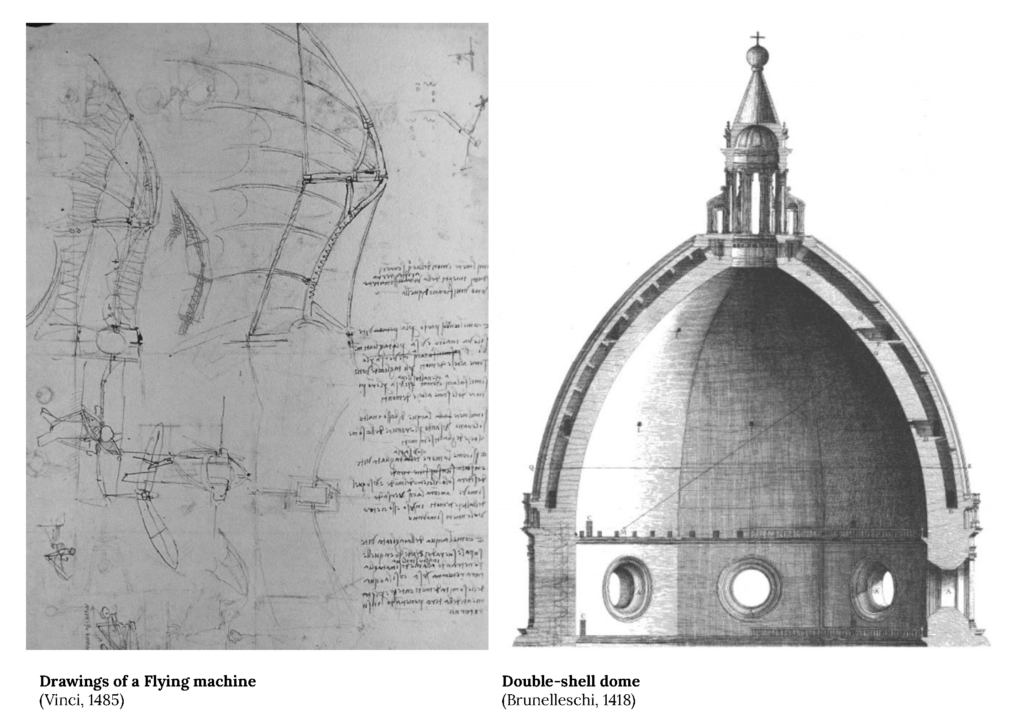
An early example of biomimetics was when Abbas bin Firnas (d. 887) tried to fly using what he knew about the anatomy of birds. Ahmed Mohammed al-Maqqari (d. 1632) described this incident saying:
“Among other very curious experiments which he made, one is his trying to fly. He covered himself with feathers for the purpose, attached a couple of wings to his body, and, getting on an eminence, flung himself down into the air, when according to the testimony of several trustworthy writers who witnessed the performance, he flew a considerable distance, as if he had been a bird, but, in alighting again on the place whence he had started, his back was very much hurt, for not knowing that birds when they alight come down upon their tails, he forgot to provide himself with one” (White, L. 1961)
TOP DOWN / BOTTOM UP

(Aziz, M. et. al. 2015)
There are two known approach’s to biomimetics; Top down and bottom up.
- Top Down: The top down approach starts with a design problem that you are trying to solve. You look for biological analogies that seem to solve your problem and then identify the principles that you can abstract to implement to your problem. You run several iterations to finally reach the final solution.
- Bottom Up: The bottom up approach starts by conducting a biological research research, analyzing it functionally, and understanding the principles behind it. You then abstract it to figure out a possible technical implementation which leads you to the final design solution.
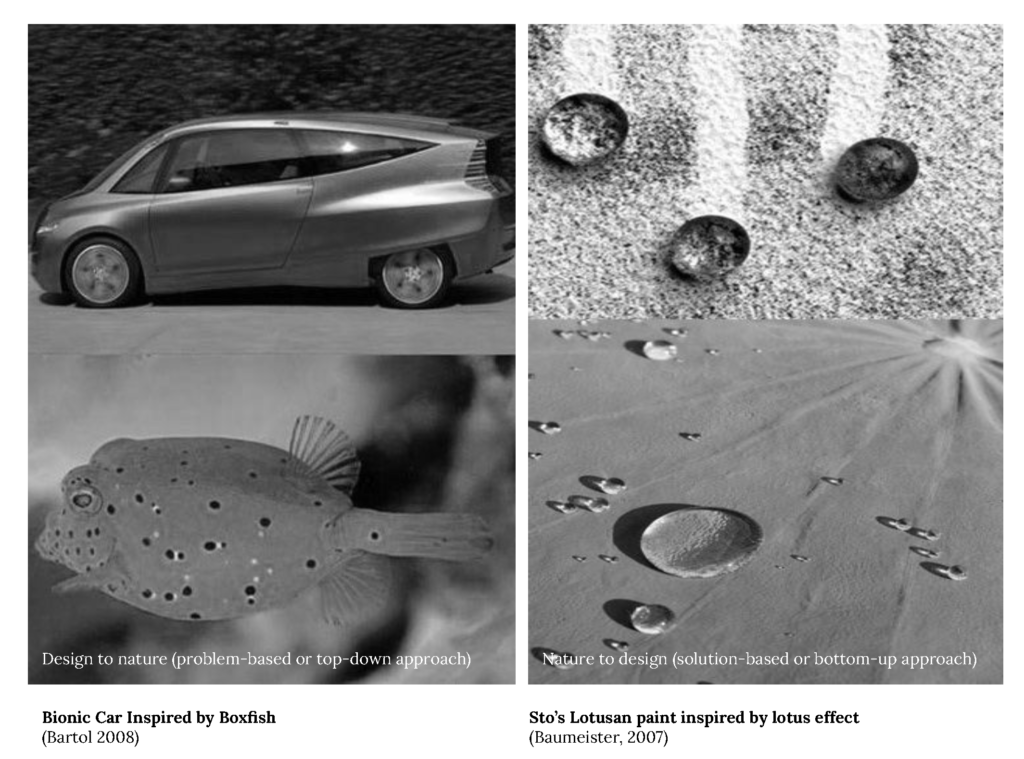
A design to nature (top down approach) example is Daimler Chrysler’s Bionic car which was adopted the boxfish form and turned it into an aerodynamic car design. Using biomimetics in this case allowed for a 20% less fuel consumption and more efficient material usage efficient. (Bartol, et al. 2008)
A nature to design (bottom up approach) example is the StoColor Lotusan coating which is a flat finish paint with a lotus like effect that allows it to be more resistant to mold, mildew and dirt, and gives it a self cleaning property, with superior resistance to weather and UV rays.
The major difference between both approaches is that the bottom up approach needs to be based on research, which may or may not be available. If it’s not available then that will require months, even years of research, making it more time and resource intensive.
LEVELS OF BIOMIMETICS
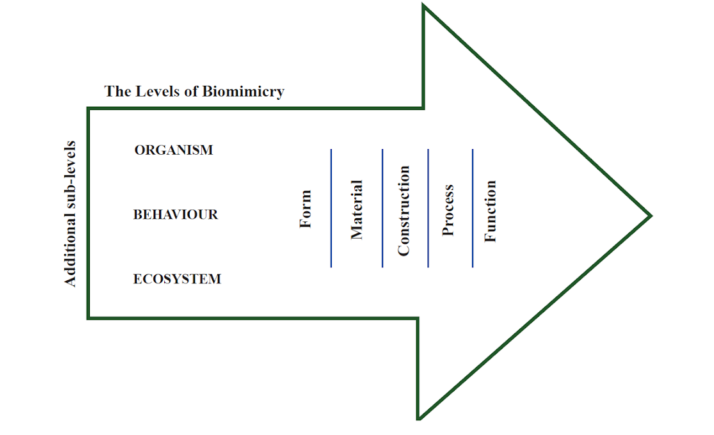
Levels of Biomimicry
There are, in effect, three levels of biomimetics. They are in order:
+ Organism
+ Behavior
+ Ecosystem.
These three levels have 5 sub levels which exist in buildings. They are:
+ Form
+ Material
+ Construction
+ Process
+ Function

Example of a building that mimics termites (Zari, 2018)
EXAMPLES OF ORGANISM LEVEL

The applications of biomimetic in architecture: Organism level (adapted from Srisuwan, T. 2019)
When work on the organism level the designer focuses on the organism adapts its form or function to his design. This does however mean that the wider context of the organism is not considered. As examples for the organism level. The Gherkin by Norman Foster, Waterloo Terminal by Grimshaw Architects, and National Aquatic Swimming Center by PTW Architects have been compared in the above table.
BIOMIMETICS LIGHT WEIGHT STRUCTURE SYSTEMS
Utilizing biomimetics in recent history in structural design has produced large span light weight structures that were not known earlier in history. An example of this is James Paxton’s famous Crystal Palace, which was a cast iron and plate glass structure, originally built in Hyde Park, London, to house the Great Exhibition of 1851 and was eventually destroyed in by a fire in 1936. The structure was inspired by the leaves of a water lily.
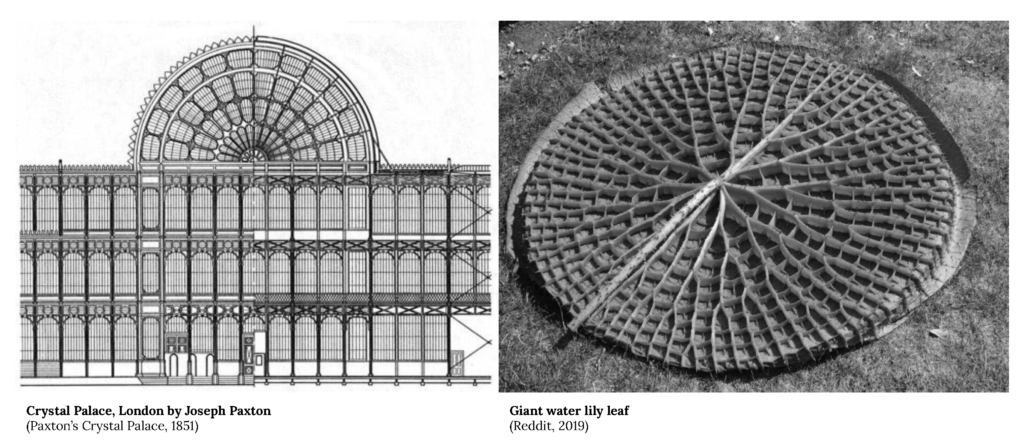
BIOMIMETICS LIGHT WEIGHT STRUCTURE SYSTEMS
The three main light weight structure systems inspired by nature that we will discuss are:
+ Shell structures
+ Cable Network Structures
+ Pneumatic Structures.
SHELL STRUCUTRES
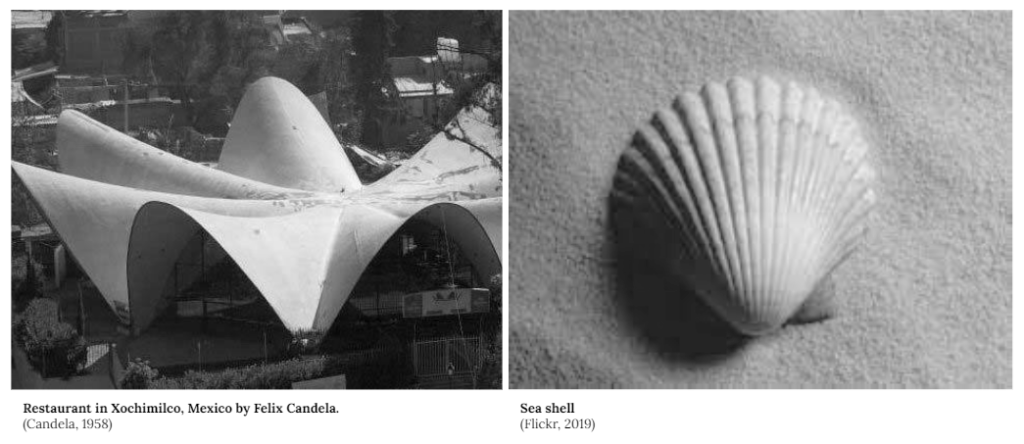
The shell, which is the most common and effective structural ingredient in nature, is a structure defined by a curved surface that has a very thin structure through which force can be transmitted in the direction of the material. Heinz Isler proposed an experimental method based on physical models to design thin concrete shell structures in 1952, while Felix Candela designed a concrete shell for a restaurant in Xochimilco, Mexico, taking Seashell as inspiration in 1958. Pier Luigi Nervi, one of the greatest civil engineers of the 20th century, made further development when developed a new hull design inspired by dome architecture using the system. rib and vault systems to increase shell strength, as seen in some hangar designs (Kim & Park, 2018). . His most famous work is the Palazzetto dello Sport, which, inspired by the leaves of the giant water lily, developed an architecture that was more efficient both in terms of time and overall cost.
CABLE NETWORK STRUCTURES

Cable network structures take inspiration from the spider’s web as a tensile structure that is efficient and strong. Frei Otto was the most famous pioneer in this system using shape finding experiments to design the Olympia park’s roof structure, built with mesh wires and made to look similar to the Alps. (Kim et al., 2018)
PNEUMATIC STRUCTURES
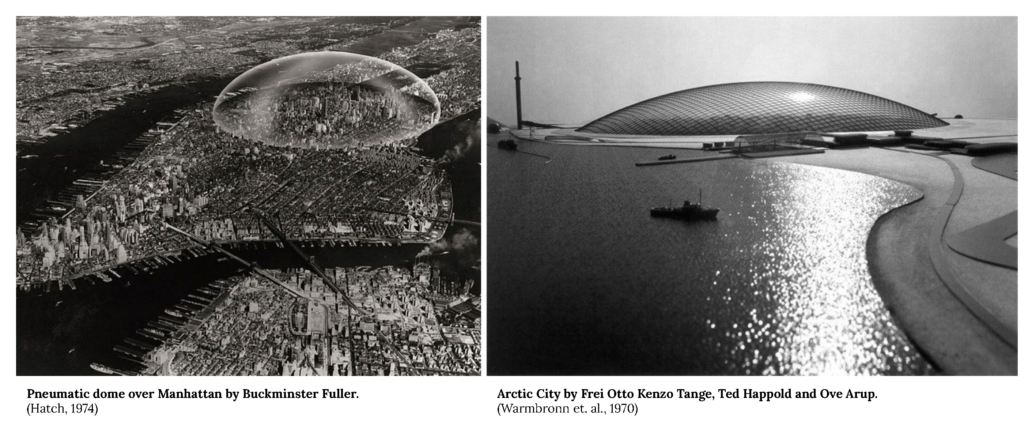
Pneumatic building design is based on the study of air bubbles, which has been explored by many architects since the mid-20th century. An example of this is Buckminster Fuller’s proposal to cover Manhattan with a pneumatic transparent dome. Another example occurred in 1971 when Frei Otto and his colleagues published a blueprint for a mining Arctic city with a population of 45,000. Recently, pneumatic structures have been developed to create a new structural concept called Tensegrity, a modified air beam that has the same load capacity as a steel beam in combination with structural elements such as cables and struts (Luchsinger, et al. 2004).
SUSTAINABILITY

(Srisuwan, T. 2019)
Abeer Mohamed ran a study on three cases of biomimetic architecture and concluded that implementing biomimetics in building design reduces energy consumption as in the table above. (Mohamed, 2018) which concurred with Baird’s study that showed biomimetic building use 17-52% less energy than surrounding buildings. (Baird, 2001)
MODERN EXAMPLES

3D printed Bird skull like structure (Exploring architecture, 2021)
Two modern examples are from the work of Michael Pawlyn and his firm exploring architecture. The first is a 3D-printed structure modelled on a cross-section of a bird’s skull. This is basically an enlarged version of a bird’s skull that was later morphed into a pavilion structure. This structure turned out to be very lightweight and structurally efficient by having domes of incredibly thin, bony material, connected together with struts and ties.

The Biorock Pavilion (exploring architecture, 2021)
The second is the Biorock Pavilion which is a concept for an amphitheatre-like event space that could be grown underwater. It is based on a seashell with a skeletal structure comprised of a network of very thin steel rods immersed in a solution of minerals with.

Minerals Calcifying on top of a steel skeleton with electricity passing through it (Exploring Architecture, 2021)
Electricity can be then run through the steel skeleton which allows the pavilion to grow as the minerals calcify on top of the base structure. It takes those minerals out of the seawater and produces a structure similar to reinforced concrete. This uses an absolute minimum of material to grow a whole building.
CONCLUSION
The implementation of biomimetics in structure clearly has resulted in improved performance and cost efficiency, and might seem like a bright future for the AEC industry. However, these examples are not numerous, and over the many years of implementation it still hasn’t become common practice. In addition, designers and engineers will always look for solutions from their recollection and if they lack sufficient knowledge about natural systems and biology it is unlikely they can implement biomimetic approach to their designs and projects. It seems that the most important next step would be to try and make knowledge of biological system a common place in construction industry, and it may be possible to take ques from the way green building has been propagated in the industry.
“Bioinspirartion in Structural Design” is a short research of IAAC, Institute for Advanced Architecture of Catalonia developed at the Masters in Advanced Computation for Architecture and Design in 2021 by Student: Basel Ghazaly and Faculty: Jane Burry